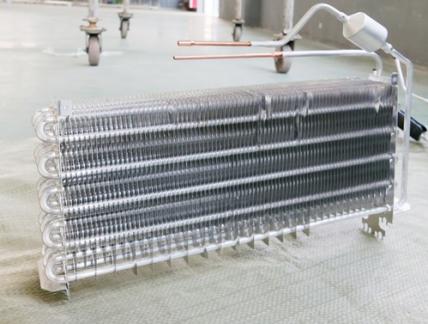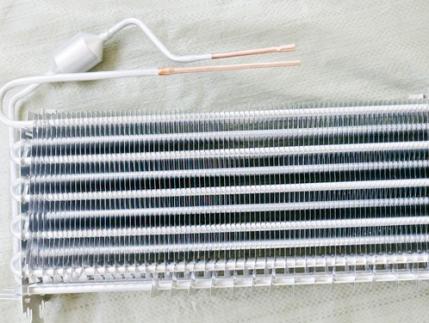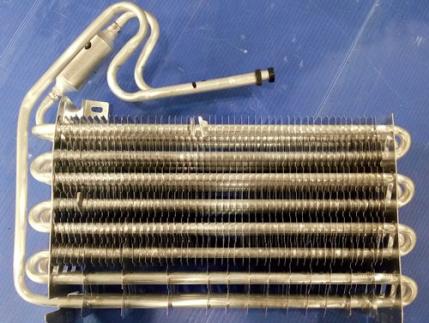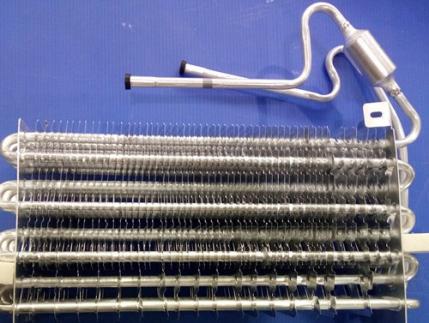News
7 ways to defrost the finned evaporator
View: 273205/08/2021The following are the 7 common defrosting methods of finned evaporator.
1. Pneumatic defrost
Pneumatic defrosting, using compressed air to generate high-speed jets to directly blow away the frost layer, removing the tiny condensed frost on the evaporator surface at any time, so that the evaporator surface is always kept frost-free. This is a defrosting method for special production process, its advantage is to ensure the continuous work of the refrigeration system, so as to improve the daily output of the device. However, due to the need for compressed air, the defrosting process is also relatively power-consuming, and the expensive price of the device is also a major disadvantage.
2. Fan reversal defrosting
Fan direction defrost, this method is based on the improvement of the direction of defrost, in the defrost process to start the fan reversal in the opposite direction of the original fan
In the defrosting process, the fan is reversed to send air in the opposite direction of the original fan, forcing the air from the non-frost side into the wind-side heat exchanger and flow to the frost side, blowing the heated air to the frost layer and defrost. This defrosting method makes full use of the heat from the wind-side heat exchanger, relying on convection, heat conduction and radiation to melt the frost at the same time. The efficiency is significantly better than that of heat conduction and radiation, thus defrosting quickly and thoroughly, while solving the problem of high condensing pressure that may arise during defrosting. The airflow generated by the reverse air supply can also prevent the water generated by the frost from penetrating into the gaps of the heat exchanger, reducing the adverse effects of water evaporation on the surface of the heat exchanger to take away heat. A certain wind pressure can also promote the frost shell disintegration from the heat exchanger surface, the addition of convective heat transfer makes the defrost process is carried out quickly and thoroughly. To meet the fan direction defrost, it is not necessary to change the original structure of the unit, only the addition of contactors, intermediate relays, time relays and pressure switches. The cost is increased.

3. Apparent heat defrost
Thermal defrosting refers to the addition of a compressor exhaust pipe to the bypass circuit in front of the electronic expansion valve in the refrigeration system to direct the high temperature and high pressure exhaust of the compressor to the front of the electronic expansion valve.
gas directly to the electronic expansion valve, and then after the electronic expansion valve throttling the compressor exhaust into the air heat exchanger, the use of compressor exhaust heat
The compressor exhaust heat is used to remove the frost layer on the outside of the air exchanger fins, while ensuring that the refrigerant is only exchanged in the air exchanger for sensible heat and not condensed. The source of heat for defrosting: the work done by the compressor and the heat stored in the compressor shell.
4. Hot gas bypass defrosting
Hot gas bypass defrosting, the system changes very slowly during the defrosting process, the mechanical impact on the compressor is relatively small when switching between heating and defrosting modes, and no heat is absorbed from the room.
When the heating and defrosting modes are switched, the mechanical impact on the compressor is relatively small, no heat is absorbed from the room, and hot air is blown out when heating is resumed, which is more comfortable. When using hot air bypass defrost, the four-way valve does not switch, open the hot air bypass solenoid valve, close the fan, the compressor exhaust from the bypass solenoid valve directly to the liquid distributor, and then enter the air heat exchanger defrost. The defrosted refrigerant enters the gas-liquid separator through the four-way valve and is finally sucked in by the compressor. In hot gas bypass defrost, defrost energy mainly comes from the input power of the compressor, without absorbing heat from circulating water and the room, and there is a large energy loss when the refrigerant flows into the liquid separator and liquid separator capillary, so the defrost time is longer than the reverse defrost. However, the room temperature will be restored soon after the heating is resumed, and the room temperature fluctuates little during the whole process, so the comfort is better.
5. Reverse defrost
Reverse defrost, is now the most common way of defrosting. Four-way valve reversal, the original high and low pressure part of the refrigeration system switch, which makes the refrigeration system 'run oil' phenomenon, reducing the reliability and service life of the system; defrost refrigerant to draw heat from the heating system for defrost, which causes sharp fluctuations in heating temperature, thus affecting the comfort of the air conditioning system; at the same time from the beginning to the end of the defrost, four-way valve to act twice, the system's high and low pressure at the same time also Switch twice to re-establish the balance, which makes the total time of the system defrosting process longer. When the reverse defrost is activated, the four-way valve switches the unit from heating cycle to defrost (cooling) cycle, closes the fan of the air heat exchanger, the refrigerant flows along the arrow in the above figure, the exhaust of the compressor enters the air heat exchanger to defrost, and the refrigerant is condensed into liquid and then throttled by the expansion valve to enter the load side heat exchanger to be evaporated into gas, which is finally sucked by the compressor. Reverse defrost energy has two sources: one is the input power of the compressor, the other is the heat absorbed from the load side heat exchanger (evaporator) circulating water.
6. Electric defrost
Electric defrost, is the use of electric heating to provide defrost heat, by installing the appropriate power in the heat exchanger resistance, when the evaporator on the frost layer accumulated to - - fixed range.
When the switch is turned on, the resistance wire is energized to melt the frost. Suitable for small refrigeration units or individual storage rooms. Electric heating elements attached to the fins, in order to prevent the melted frost water before the discharge of the storehouse again ice, but also must be tied around the water receiving plate and drainage pipe band heater, melted frost water should be promptly discharged to the outside of the storehouse. Electric defrost has the advantages of simple system, complete defrost, and simple realization control, and is widely used in small installations. The main disadvantage is energy consumption, single . Pure electric heat to melt the frost layer of the defrost method is the most costly energy consumption of all methods. In large and medium-sized cold storage refrigeration system is generally rarely used purely thermoelectric defrost method.
7. Water frosting
Water flush frost is the use of water spray device to the evaporator external surface spray water, so that the frost layer is melted by the heat of the water and flush off a. A method. A kind of method. Water flush frost is applicable to the direct expansion chiller refrigeration system. Generally and hot air bypass defrost combined application, alone only suitable for the chiller frost slow, the frost layer is relatively thin situation. Water flushing frost than hot air bypass defrost effect is good, and short time, simple operation, easy to manage. However, using this method the oil in the evaporator pipeline can not be discharged, water consumption is large, so its use is limited to chillers with drainage pipes. Operation should be 0.5h in advance to flush the chiller's liquid supply valve closed, and slightly open the chiller's air return valve. Start the special frost pump, about 25 "C water will be pumped above the chiller exhaust pipe, the evaporator for water flushing frost.

The above content has made a brief introduction to different ways of defrosting the finned evaporator. Different defrosting methods have their own advantages and disadvantages, and the choice of which defrosting method depends on the needs of the system and cost control.

 Service Hotline:
Service Hotline: 中文
中文 Product Categories
Product Categories





 Address: Lijia Town, Wujin District, Changzhou City, Jiangsu Province
Address: Lijia Town, Wujin District, Changzhou City, Jiangsu Province Fax: 0086 519 86233778(Sales Department)
Fax: 0086 519 86233778(Sales Department) Tel: 0086 519 86233778(Sales Department)
Tel: 0086 519 86233778(Sales Department) Email:
Email: 





View More(Total0)Comment Lists